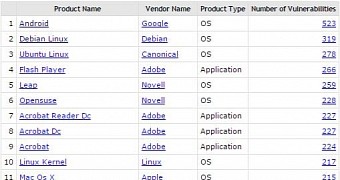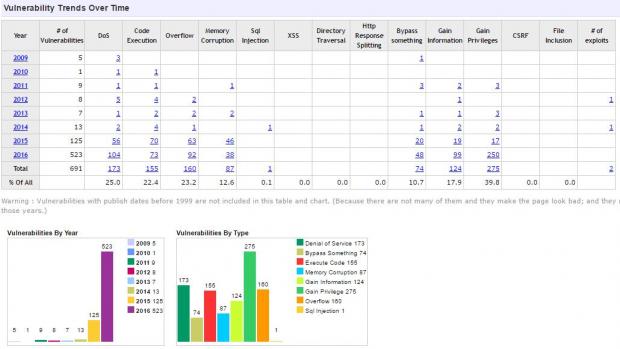Statistics provided by CVE Details, an online database that collects and stores information on software security vulnerabilities, reveal that Android, Debian Linux, and Ubuntu Linux were the three most vulnerable products in 2016.
Android had the biggest number of vulnerabilities during the year - 523, followed by Debian Linux with 319 and Ubuntu Linux with 278. Surprisingly, Adobe’s Flash Player only came fourth with 266 vulnerabilities, even though it was number one for a long time.
As far as “leader” Android is concerned, these stats show a worrying increase in the number of Denial of Service vulnerabilities in 2016, but also a drop in memory corruption flaws for the mobile operating system. Specifically, the number of DoS vulnerabilities jumped from 56 in 2015 to no less than 104 the past year, while memory corruption glitches declined from 46 to 38.
There were also 99 vulnerabilities in Android that allowed for information to be leaked, a jump from 19 the year before, as well as 250 security bugs that enabled elevation of privileges, a shocking increase from just 17 of them in 2015.
Microsoft has fewer vulnerabilities
If you’re looking for Microsoft, their first product on the list is Windows 10 with 172 vulnerabilities for the year, followed by Windows Server 2012 with 156.
CVE Details has also created a chart that ranks vendors by the number of vulnerabilities in their products, with Google leading the pack with 695 flaws, followed by Debian and Canonical with 319 and 278, respectively.
On the other hand, these statistics do not seem to be accurate, as in some cases, the same vulnerabilities are counted more than once - as is the case of Windows and Adobe, where the same security flaw exists in more than just a product or version of their software.
What’s also important to note is that a higher number of vulnerabilities doesn’t necessarily mean that these products are less secure than others. Many of these vulnerabilities were privately reported and fixed by parent companies before any exploits were developed, so in most of the cases, their customers were on the safe side all the time.

 14 DAY TRIAL //
14 DAY TRIAL // 

